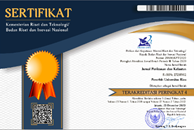Correlation of Total Oil Content with Planktonic Diatoms (Bacillariophyceae) in the Waters of Bengkalis Straits, Pangkalan Jambi Village Bengkalis Regency
(1) Department of Marine Science, Faculty of Fisheries and Marine, Universitas Riau
(2) Department of Marine Science, Faculty of Fisheries and Marine, Universitas Riau
(3) Department of Marine Science, Faculty of Fisheries and Marine, Universitas Riau
(*) Corresponding Author
Abstract
Keywords
Full Text:
PDFReferences
[APHA] American Public Health Association. 1992. Standard Methods for the examination of water and Wastewater. Washington DC. 769p
Abida, I.W. (2016). Struktur komunitas dan kelimpahan fitoplanton di perairan Muara Sungai Porong Sidoarjo. Rekayasa, 2(2).
Adriana, A., Thamrin, T., Siregar, S.H. (2017). Struktur komunitas fitoplankton di perairan Tanjung Balai Kota Kabupaten Karimun Provinsi Kepulauan Riau. Jurnal Perikanan dan Kelautan, 22(2): 18-26
Effendi, H. (2003). Telaah kualitas air: bagi pengelolaan sumber daya dan lingkungan perairan. Kanisius. Yogyakarta.
Fitri, W. E. (2011). Jenis-jenis dan variasi morfologi diatom pada dua kawasan mangrove (Sungai Pisang, Kota Padang dan Air Bangis, Pasaman Barat, Sumatera Barat). Program Pasca Sarjana Universitas Andalas. Padang.
Hadi, A. (2005). Principles of environmental sampling management. PT. Gramedia Pustaka Utama. Jakarta.
Hutagalung, H.P. (2010). Pengaruh mineral terhadap organisme laut. Oseana, 25(1): 13-27
Sinaga, O.L.B., Siregar, S.H., Nedi, S. (2022). Analisis of total oil content and planktonic diatom (Bacillariophyceae) in the water of Lalang Strait, Mengkapan Village Siak Regency. Jurnal Perikanan dan Kelautan, 27(2): 129-135.
Sugiyono. (2017). Metode penelitian kuantitatif, kualitatif, dan R&D. Bandung : Alfabeta CV.
Article Metrics
Abstract view : 99 timesPDF - 25 times
DOI: http://dx.doi.org/10.31258/jpk.29.1.27-31
Copyright (c) 2024 Bintang Rapshodio Tane, Aras Mulyadi, Irvina Nurrachmi

This work is licensed under a Creative Commons Attribution-NonCommercial-NoDerivatives 4.0 International License.
Gedung Marine Center Lt 2. Fakultas Perikanan dan Kelautan Universitas Riau



